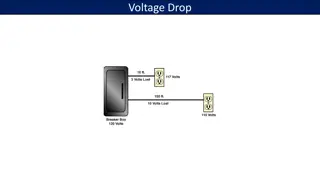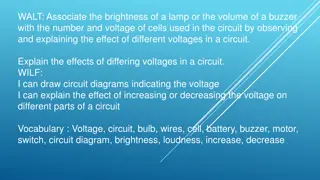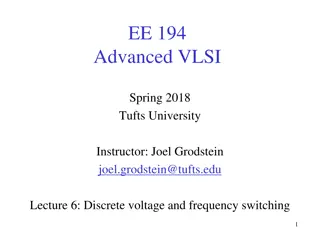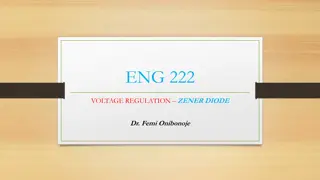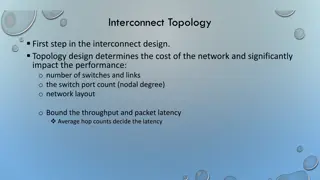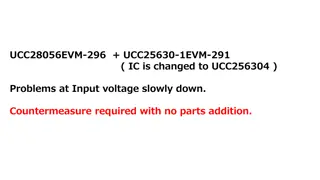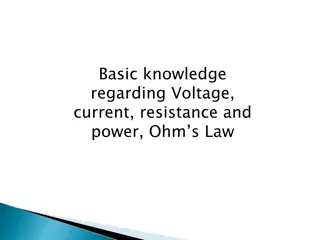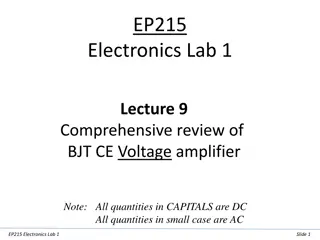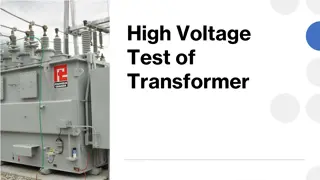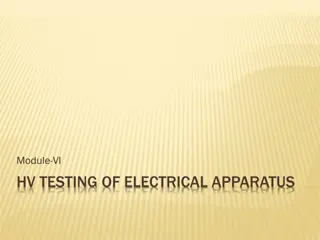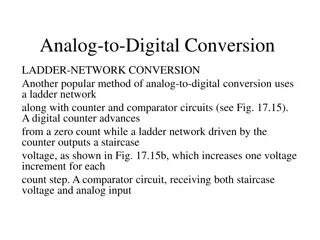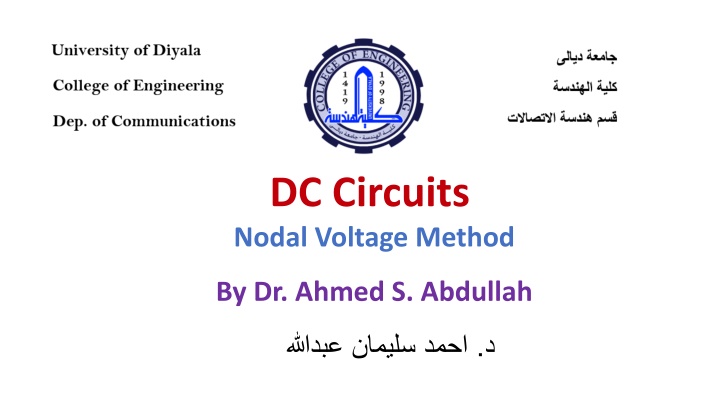
Nodal Voltage Method for DC Circuits Analysis
Explore the Nodal Voltage Method for analyzing DC circuits using Kirchhoff's current law to determine unknown voltages at different nodes in the network. Learn how to convert voltage sources to current sources, identify nodes, apply KCL, and solve for node voltages with detailed examples.
Download Presentation

Please find below an Image/Link to download the presentation.
The content on the website is provided AS IS for your information and personal use only. It may not be sold, licensed, or shared on other websites without obtaining consent from the author. If you encounter any issues during the download, it is possible that the publisher has removed the file from their server.
You are allowed to download the files provided on this website for personal or commercial use, subject to the condition that they are used lawfully. All files are the property of their respective owners.
The content on the website is provided AS IS for your information and personal use only. It may not be sold, licensed, or shared on other websites without obtaining consent from the author.
E N D
Presentation Transcript
DC Circuits Nodal Voltage Method By Dr. Ahmed S. Abdullah .
Nodal Voltage Method Nodal voltage analysis applies KCL to find unknown voltages. A node is the point of connection between two or more branches. The nodal voltage method is applied as follows: Step 1 : Convert each voltage source in the network to its equivalent current source. Step 2 : Determine the number of nodes within the network. Step 3 : Pick a reference node, and label each remaining node with a subscripted value of voltage: V1, V2, and so on. Step 4 : Apply Kirchhoff s current law at each node except the reference. Step 5 : Solve the resulting equations to obtain the unknown node voltages.
Nodal Voltage Method EXAMPLE: Using the nodal voltage method, determine the currents in R1, R2and R3, in the circuit shown.
Nodal Voltage Method EXAMPLE: Using the nodal voltage method, determine the currents in R1, R2and R3, in the circuit shown. Solution: Step 2 : Determine the number of nodes within the network.
Nodal Voltage Method EXAMPLE: Using the nodal voltage method, determine the currents in R1, R2and R3, in the circuit shown. Solution: Step 3 : Pick a reference node, and label each remaining node with a subscripted value of voltage: V1, V2, and so on.
Nodal Voltage Method EXAMPLE: Using the nodal voltage method, determine the currents in R1, R2and R3, in the circuit shown. Solution: Step 4 : Apply Kirchhoff s current law at each node except the reference.
Nodal Voltage Method EXAMPLE: Using the nodal voltage method, determine the currents in R1, R2and R3, in the circuit shown. Solution: Step 4 : Apply Kirchhoff s current law at each node except the reference. For node 1 : Applying Kirchhoff s current law:
Nodal Voltage Method EXAMPLE: Using the nodal voltage method, determine the currents in R1, R2and R3, in the circuit shown. Solution: Step 4 : Apply Kirchhoff s current law at each node except the reference. For node 1 : Applying Kirchhoff s current law:
Nodal Voltage Method EXAMPLE: Using the nodal voltage method, determine the currents in R1, R2and R3, in the circuit shown. Solution: Step 4 : Apply Kirchhoff s current law at each node except the reference. For node 1 : Applying Kirchhoff s current law:
Nodal Voltage Method EXAMPLE: Using the nodal voltage method, determine the currents in R1, R2and R3, in the circuit shown. Solution: Step 4 : Apply Kirchhoff s current law at each node except the reference. For node 2 : Applying Kirchhoff s current law:
Nodal Voltage Method EXAMPLE: Using the nodal voltage method, determine the currents in R1, R2and R3, in the circuit shown. Solution: Step 4 : Apply Kirchhoff s current law at each node except the reference. For node 2 : Applying Kirchhoff s current law:
Nodal Voltage Method EXAMPLE: Using the nodal voltage method, determine the currents in R1, R2and R3, in the circuit shown. Solution: Step 5 : Solve the resulting equations to obtain the unknown node voltages. producing
Nodal Voltage Method EXAMPLE: Using the nodal voltage method, determine the currents in R1, R2and R3, in the circuit shown. Solution: Step 5 : Solve the resulting equations to obtain the unknown node voltages. =+7 1 +3= 7)(3 1 1 = 21 1 = +20 1 1 =+48 1 +3= 48)(3 1 24 = 144 24 = 120 24 2 =+7 +48 24= 7)( 24 48 1 = 168 + 48 = 120 1 ?1= 1 =120 +20= +6 ? and ?2= 2 = 120 +20= 6 ?
Nodal Voltage Method EXAMPLE: Using the nodal voltage method, determine the currents in R1, R2and R3, in the circuit shown. Solution: Step 5 : Solve the resulting equations to obtain the unknown node voltages. ?1= +6 ? and ?2= 6 ? ?R1= ?1=?1 =+6 +2= +? ? ?1 ?R2= ?2=?2 = 6 +6= ? ? ?2 The minus signs indicate that the current has opposite direction Since V1is greater than V2, the current through R3 passes from V1 to V2. Its value is ?R3= ?3=?1 ?2 =+6 ( 6) +12 =+12 +12= +? ? ?3
Nodal Voltage Method EXAMPLE: By using nodal voltage method, find the voltage across the 3 resistor of the circuit shown.
Nodal Voltage Method EXAMPLE: By using nodal voltage method, find the voltage across the 3 resistor of the circuit shown. Solution: Converting sources and choosing nodes, we have
Nodal Voltage Method EXAMPLE: By using nodal voltage method, find the voltage across the 3 resistor of the circuit shown. Solution: Converting sources and choosing nodes, we have
Nodal Voltage Method EXAMPLE: By using nodal voltage method, find the voltage across the 3 resistor of the circuit shown. Solution: Converting sources and choosing nodes, we have
Nodal Voltage Method EXAMPLE: By using nodal voltage method, find the voltage across the 3 resistor of the circuit shown. Solution: Converting sources and choosing nodes, we have
Nodal Voltage Method EXAMPLE: By using nodal voltage method, find the voltage across the 3 resistor of the circuit shown. Solution: Converting sources and choosing nodes, we have Resulting in
Nodal Voltage Method EXAMPLE: By using nodal voltage method, find the voltage across the 3 resistor of the circuit shown. Solution: Solve the resulting equations to obtain the unknown node voltages.
Nodal Voltage Method EXAMPLE: By using nodal voltage method, find the voltage across the 3 resistor of the circuit shown. Solution: Solve the resulting equations to obtain the unknown node voltages. =+11 2 +18= 11)(18 2 5 = 198 10 = +188 5
Nodal Voltage Method EXAMPLE: By using nodal voltage method, find the voltage across the 3 resistor of the circuit shown. Solution: Solve the resulting equations to obtain the unknown node voltages. =+11 2 +18= 11)(18 2 5 = 198 10 = +188 5 2 =+11 +48 3 = 11)( 3 48 5 = 33 + 240 = +207 5
Nodal Voltage Method EXAMPLE: By using nodal voltage method, find the voltage across the 3 resistor of the circuit shown. Solution: Solve the resulting equations to obtain the unknown node voltages. =+11 2 +18= 11)(18 2 5 = 198 10 = +188 5 2 =+11 +48 3 = 11)( 3 48 5 = 33 + 240 = +207 5 ?3 = ?2= 2 =+207 +188= 1.101 ?
Nodal Voltage Method EXAMPLE: By using nodal voltage method, find the voltage across the 6 resistor of the circuit shown.
Nodal Voltage Method EXAMPLE: By using nodal voltage method, find the voltage across the 6 resistor of the circuit shown.
Nodal Voltage Method EXAMPLE: By using nodal voltage method, find the voltage across the 6 resistor of the circuit shown. Solution: Step 2 : Determine the number of nodes within the network.
Nodal Voltage Method EXAMPLE: By using nodal voltage method, find the voltage across the 6 resistor of the circuit shown. Solution: Step 3 : Pick a reference node and label each remaining node with a subscripted value of voltage: V1, V2, and V3.
Nodal Voltage Method EXAMPLE: By using nodal voltage method, find the voltage across the 6 resistor of the circuit shown. Solution: Step 4 : Apply Kirchhoff s current law at each node except the reference. 1 2+1 4 2 4 1 1 For node 1 : ?1 ?2 ?3= 1 1 2+1 8+1 1 2 1 6 For node 2 : ?2 ?1 ?3= 0 6 1 4+1 6+1 1 4 1 6 For node 3 : ?3 ?1 ?2= 0 8
Nodal Voltage Method EXAMPLE: By using nodal voltage method, find the voltage across the 6 resistor of the circuit shown. Solution: Step 4 : Apply Kirchhoff s current law at each node except the reference. 1 2+1 4 2 4 1 1 ?1 ?2 ?3= 1 1 2+1 8+1 1 2 1 6 ?2 ?1 ?3= 0 6 1 4+1 6+1 1 4 1 6 ?3 ?1 ?2= 0 8 3 4 1 2 1 4 ?1 ?2 ?3= 1 19 24 1 2 1 6 ?2 ?1 ?3= 0 13 24 1 4 1 6 ?3 ?1 ?2= 0
Nodal Voltage Method EXAMPLE: By using nodal voltage method, find the voltage across the 6 resistor of the circuit shown. Solution: Step 4 : Apply Kirchhoff s current law at each node except the reference. 3 4 2 4 1 1 ?1 ?2 ?3= 1 19 24 13 24 1 2 1 4 1 6 1 6 ?2 ?1 ?3= 0 ?3 ?1 ?2= 0
Nodal Voltage Method EXAMPLE: By using nodal voltage method, find the voltage across the 6 resistor of the circuit shown. Solution: Step 4 : Apply Kirchhoff s current law at each node except the reference. 3 4 2 4 1 1 ?1 ?2 ?3= 1 19 24 13 24 1 2 1 4 1 6 1 6 ?2 ?1 ?3= 0 ?3 ?1 ?2= 0 Rearrange, then: 3 4 1 2 1 4 ?1 ?2 ?3= 1 1 19 24 1 6 ?1+ ?2 ?3= 0 2 1 1 6 13 24 ?1 ?2+ ?3= 0 4
Nodal Voltage Method EXAMPLE: By using nodal voltage method, find the voltage across the 6 resistor of the circuit shown. Solution: Step 4 : Apply Kirchhoff s current law at each node except the reference. 3 4 1 2 1 4 ?1 ?2 ?3= 1 1 19 24 1 6 ?1+ ?2 ?3= 0 2 1 1 6 13 24 ?1 ?2+ ?3= 0 4 3?1 2?2 ?3= 4 12?1+ 19?2 4?3= 0 6?1 4?2+ 13?3= 0
Nodal Voltage Method EXAMPLE: By using nodal voltage method, find the voltage across the 6 resistor of the circuit shown. Solution: Step 5 : Solve the resulting equations to obtain the unknown node voltages. 3?1 2?2 ?3= 4 12?1+ 19?2 4?3= 0 +3 12 6 2 +19 4 1 4 +13 = =171 6?1 4?2+ 13?3= 0 +3 12 6 4 0 0 1 4 +13 2= =720 +3 12 6 2 +19 4 4 0 0 3= =648 ?2= 2 =720 171= 4.21 ? and ?3= 3 =648 ?6 = ?2 ?3= 4.21 3.79 = 0.42 ? 171= 3.79?
Nodal Analysis with Voltage Sources Special cases CASE 1 If a voltage source is connected between the reference node and a nonreference node, we simply set the voltage at the nonreference node equal to the voltage of the voltage source.
Nodal Analysis with Voltage Sources Special cases CASE 1 If a voltage source is connected between the reference node and a nonreference node, we simply set the voltage at the nonreference node equal to the voltage of the voltage source. In Figure shown, for example,
Nodal Analysis with Voltage Sources Special cases CASE 1 If a voltage source is connected between the reference node and a nonreference node, we simply set the voltage at the nonreference node equal to the voltage of the voltage source. In Figure shown, for example, In this circuit, we have 3 node voltages: ?? ,??,??? ??
Nodal Analysis with Voltage Sources Special cases CASE 1 If a voltage source is connected between the reference node and a nonreference node, we simply set the voltage at the nonreference node equal to the voltage of the voltage source. In Figure shown, for example, In this circuit, we have 3 node voltages: ?? ,??,??? ?? ??? ??= ?? ? Thus, our analysis is somewhat simplified by this knowledge of the voltage at this node.
Nodal Analysis with Voltage Sources Special cases In this circuit, we have 3 node voltages: ?? ,??,??? ?? ??? ??= ?? ? 1 2+1 8+1 1 2 1 6 ?2 ?1 ?3= 0 6 1 4+1 6+1 1 4 1 6 ?3 ?1 ?2= 0 8 19 24 1 2 1 6 ?2 10 ?3= 0 13 24 1 4 1 6 ?3 10 ?2= 0
Nodal Analysis with Voltage Sources Special cases 19 24 1 2 1 6 ?2 10 ?3= 0 13 24 1 4 1 6 ?3 10 ?2= 0 19 24 1 6 ?2 ?3= 5 13 24 1 6 ?2=10 ?3 4 19?2 4?3= 120 -4?2+ 13?3= 60
Nodal Analysis with Voltage Sources Special cases 19?2 4?3= 120 =+19 4 +13= 19)(13 4 4 = 247 16 = 231 -4?2+ 13?3= 60 4 2 =+120 4 +13= 120)(13 4 60 = 1560 + 240 = 1800 +60 3 =+19 120 +60= 19)(60 120 4 = 1140 + 480 = 1620 4 ?2= 2 =1800 231= 7.79 ? and ?3= 3 =1620 231= 7.01?
References Boylestad, Robert L. Introductory circuit analysis. Pearson Education, 2010. Robbins, Allan H., and Wilhelm C. Miller. Circuit analysis: Theory and practice. Cengage Learning, 2012. Sadiku, Matthew NO, and Chales K. Alexander. Fundamentals of electric circuits. McGraw-Hill Higher Education, 2007.


